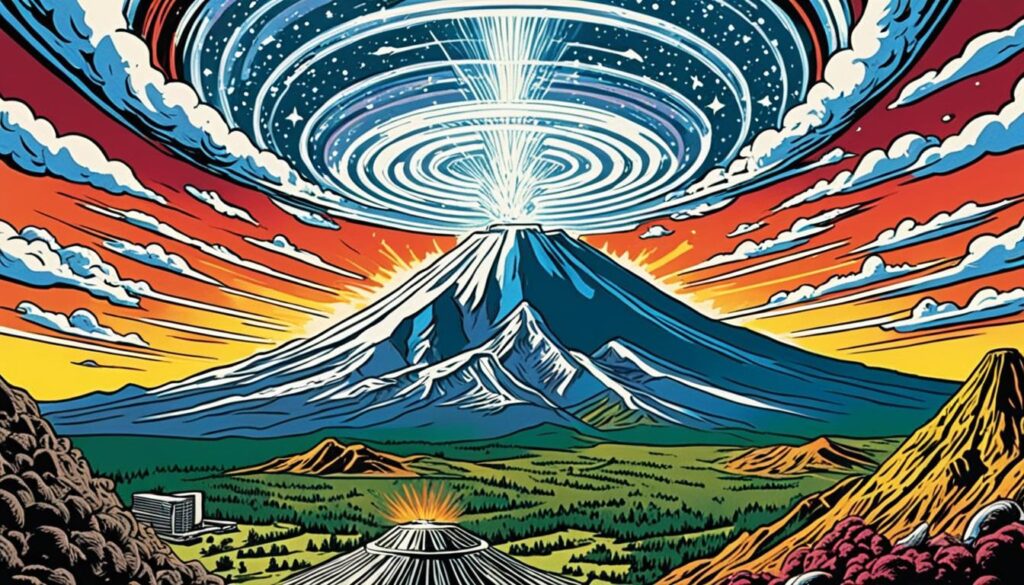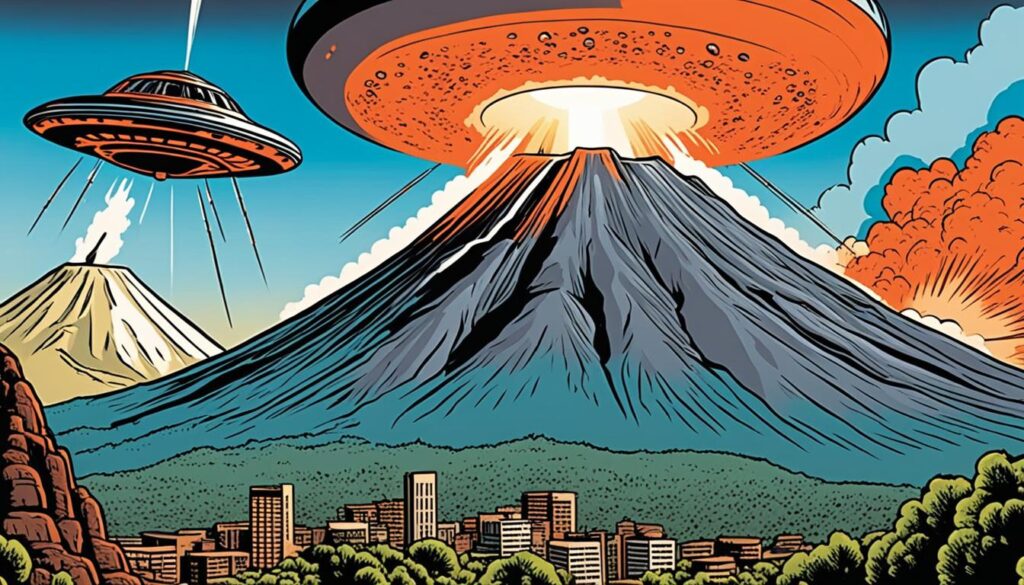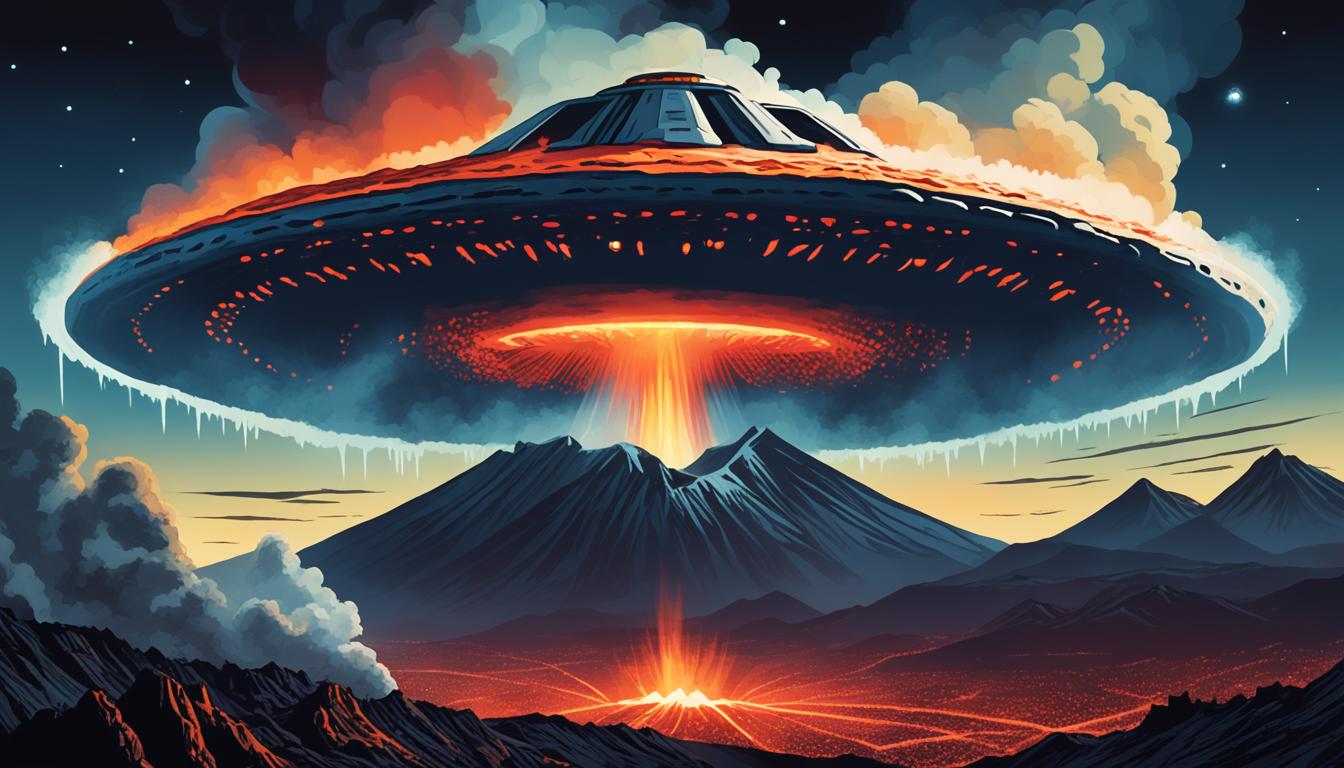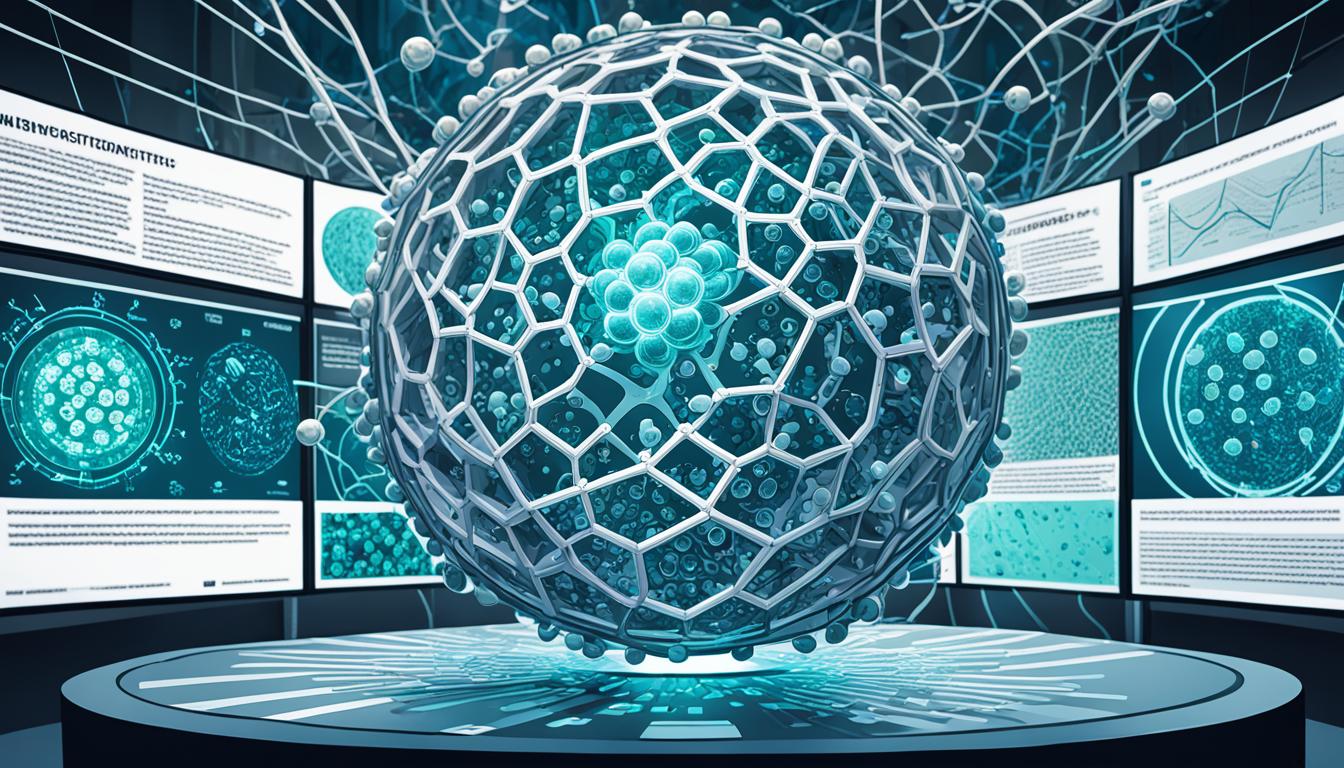People all over the world are fascinated by UFO sightings. From strange lights to unexplained flying objects, these mysteries make us wonder. Recently, researchers found something interesting. There’s more UFO activity around active volcanoes in Latin America, especially around Mexico’s Popocatepetl volcano.
Locals call it “Popo.” It’s an active volcano close to Puebla, 45 miles southwest of Mexico City. It’s known for its eruptions and beauty. But lately, more UFO sightings near the volcano have caught everyone’s eye, from UFO fans to skeptics.
This rise in UFO sightings around Popocatepetl has been happening for years. In 1986, mountain climbers went into the volcano’s crater. They noted the crater’s rim is 5,250 meters high. Inside, they found a smaller crater and a warm lake on the crater’s floor, with a temperature of 29°C1.
More UFO evidence came to light later. In 1989, people visiting the volcano saw new fumaroles releasing steam and gas. These openings were on the main crater and its south flank. Steam shot up 20 meters high, smelling slightly of sulfur1.
In 1990, a seismic station was set up near Tlamacas, close to the volcano. It picked up small earthquakes around the volcano. These quakes showed that sulfur was condensing inside the crater1.
The UFO sightings kept increasing. By 1993, more steam was coming out of the crater. Researchers also noted the seismic station at Tlamacas showed normal seismic activity1.
In 1993, the people of Puebla noticed more steam plumes. The lake’s temperature inside the crater went from 29°C in 1986 to 51°C in 1993. Also, about 30 new vents were found, adding to the mystery of the volcano’s link to UFOs1.
In June 1993, the excitement grew. Climbers reached the summit on January 3. They saw bigger emissions from the volcano. The crater’s major and minor axes and the elevation difference were all measured, showing the volcano’s grand scale1.
Key Takeaways:
- The Popocatepetl volcano in Mexico has seen an increase in UFO activity, intriguing both UFO enthusiasts and skeptics.
- In 1986, mountain climbers discovered a warm lake on the E floor of the summit crater and measured the dimensions of the crater.
- Observations in 1989 revealed fumaroles emitting high-pressure gas and steam, while seismic activity persisted in 1990.
- In 1993, researchers noticed increased fumarolic activity and rising lake temperatures, accompanied by an uptick in plumes and larger emissions.
The Popocatepetl Volcano
Located in Mexico, Popocatepetl is a stratovolcano active since 19942. It stands tall at 17,797 feet, making it a key figure among the world’s volcanoes. Its location near Mexico City puts over 22 million people at risk.
The volcano is known for its toxic fumes, ash, and incandescent rocks2. It has disrupted life for nearly 30 years. Eruptions often force schools and airports to close. This includes Mexico City’s Benito Juarez and the Felipe Angeles airports3.
Due to regular eruptions, the alert level has been raised to “yellow phase three”3. This means we need better emergency plans as activity increases. A volcanic ash plume has even gone higher than 30,000 feet, making the concern greater3.
About 90% of the world’s volcanoes, including Popocatepetl, lack constant monitoring3. But, efforts to watch them are improving. The VOLCAT system uses satellite data for quick eruption alerts3.
UFO Sightings and Volcanic Hotspots
There’s an interesting link between UFO sightings and volcanic hotspots, especially in Latin America. It seems that volcanic activity might draw in UFOs. This results in more UFO sightings around these areas. A key spot for such activity is Mexico’s Popocatepetl volcano.
The Popocatepetl volcano stands tall at 17,800 feet4. It’s among Mexico’s most active volcanoes4. Its constant activity and eruptions catch the eye of UFO fans. Recently, two UFOs were reported entering the volcano’s crater4.
Yet, Popocatepetl isn’t alone in this. Other Latin American volcanic areas report UFO sightings too. For instance, Colima witnessed 11 UFO sightings from 1999 to 20115. The Michoacan-Guanajuato region had four sightings between 1943 and 19525. These reports suggest a strong link between volcanoes and UFOs.
Skinwalker Ranch in Utah is another spot known for UFO sightings. It has become famous for such activity. The ranch even inspired a TV series on the History Channel in 2020 titled “The Secret of Skinwalker Ranch”4. This series delves into the ranch’s mysteries and its UFO connections.
When UFOs are seen entering the Popocatepetl volcano, it sparks debate. The volcano’s interior reaches about 1,832 degrees Fahrenheit4. Some think this indicates the UFOs aren’t from Earth. They argue that such objects must withstand incredible heat, suggesting a non-human origin.
This link between UFOs and volcanic hotspots in Latin America opens up intriguing questions. Are these sightings explained by science or something more mysterious? Exploring these events further is key to finding answers.
Increased UFO Activity Over Popocatepetl Volcano
The Popocatepetl volcano in Mexico is a hotspot for UFO sightings. Enthusiasts and skeptics are drawn to this place. Strange lights and objects have been seen around the volcano, creating lots of talk about what they could be. While some people think there’s a simple explanation, the sheer number of sightings raises questions.
On January 8, a picture showed a UFO near the erupting volcano. This photo, by Luis Guerra, became hugely popular online. The person who took it lives close to a UFO monument in Atlixco, Puebla, Mexico6.
The volcano, standing around 10,000 feet tall, adds mystery to these occurrences. Atlixco is known for spooky events, like UFOs and Chupacabra sightings7. In the ’90s, this place was a major UFO spot. A special UFO sculpture stands on a hill known for sightings since 20017.
These recent UFO reports near the Popocatepetl are not alone. Mexico’s history is rich with UFO stories, from Tula to sightings across Mexico and the U.S. These reports keep people interested in the UFO phenomenon6.
UFO sightings aren’t just in Mexico. They’ve been reported worldwide for centuries. In the 1600s, Puritans recorded them without mentioning aliens. The famous 1947 Roswell event led to a boom in sighting reports8. Places like Wycliffe Well, Warminster, and the Nazca Lines also witness these mysterious events, keeping our interest in possible extraterrestrial life alive8.
| Location | Statistical Data |
|---|---|
| Popocatepetl Volcano, Mexico | Increased UFO activity during eruptions |
| Atlixco, Mexico | Known as a paranormal hotspot with numerous UFO sightings |
| Tula, Hidalgo | Prior reported flying saucer sighting in Mexico |
| Mexico and U.S. | Reports of flicker in orange lights in various cities |

People’s growing interest in UFOs is clear from the viral photos and stories. Despite doubts, the activity near Popocatepetl and elsewhere keeps many hooked. As we learn more about space, our hunt for answers about these unidentified objects continues to excite us.
Skepticism and Explanations
Many skeptics attribute UFO sightings to common, earthly sources. For example, they suggest the UFOs seen over Popocatepetl volcano are just airplanes. But, the strong evidence and stories from witnesses call for a deeper look.
A lot of people have seen UFOs near Popocatepetl. This has happened over several years9. These experiences are hard to ignore. Researchers from Harvard found unusual seismic shifts and electromagnetic fields in the volcano9. It hints at an energy source that’s not from natural volcanic actions, maybe even man-made9. These unusual signs make us question the usual explanations and consider new ideas.
There’s a theory that aliens might be using Popocatepetl as a base, which has made many scientists skeptical9. They think the UFOs might just be mistaken identities or optical illusions. Yet, it’s key to stay open and check these claims carefully and without bias.
Challenging Common Misconceptions
The Harvard group showed how bringing different scientists together is valuable9. They combine their knowledge to figure out the phenomena’s real cause. This kind of science can help answer doubts with facts and real evidence.
Encouraging Further Exploration
Looking forward, new tech like deep radar and satellites might shed light on the UFOs near Popocatepetl9. Using these tools, we can learn more about the mysterious sights. Plus, teamwork across countries and from many labs will help keep the study honest and open9. Working together, we can get to the bottom of this intriguing mystery.

| Common Explanations | Counter Arguments |
|---|---|
| UFO sightings are misidentifications or illusions caused by natural phenomena. | Eyewitness testimonies and advanced monitoring equipment provide compelling evidence of anomalous activity. |
| The flying object captured in photos and videos is an airplane. | The research conducted by the Harvard team suggests an additional source of energy beyond typical volcanic activity9. |
| There is no concrete proof of extraterrestrial presence or advanced civilizations. | The anomalous seismic readings and electromagnetic pulses point to potential artificial origins9. |
As investigations go on, it’s crucial to weigh skepticism against the facts and stories we have. While there may be normal reasons for these events, the oddities at Popocatepetl deserve more study and scientific work.
Underground Civilizations?
A rare idea about UFOs near the Popocatepetl volcano is the cryptoterrestrial hypothesis. It suggests there might be smart beings living underground. These beings could be behind the UFO sightings. Scientists doubt this theory, but it’s worth thinking about.
Those who believe in this theory say these underground societies are ancient. They might have secret bases in big volcanoes like Popocatepetl. They use advanced tech to stay hidden and explore Earth.
The Hotspot of Popocatepetl Volcano
The Popocatepetl volcano in Mexico is famous for UFO sightings. There’s a long history of mysterious flying object reports here. UFO fans and experts find it very intriguing.
Statistics10 show that since 1969, there have been over 200,000 UFO reports. The US reports the most. The Department of Defense’s AARO office looks into these cases. Over 800 involve flight safety issues.
This unusual hypothesis gives a different reason for the UFOs around Popocatepetl. Maybe underground communities use special tech for this. Most scientists don’t agree, though.
Connecting the Dots
The idea of hidden civilizations beneath us is intriguing. We know so little about Earth’s history. Missing fossil records make us wonder what’s hidden below.
Supporters of the cryptoterrestrial hypothesis11 point to mysterious archaeological finds. Like a Stonehenge-like structure in Lake Michigan and the Ganonpadon site, which could be very old. These may hint at a secret past.
Statistical data11 links half of UFO sightings to water. The Disclosure Act even talks about submariners seeing UFOs. This supports the theory of active underwater and underground beings.
We can’t prove if underground societies exist. Yet, it’s valuable to stay open to new explanations for UFOs near Popocatepetl. Exploring these ideas can unlock more mysteries of our planet.

Other Theories Surrounding UFOs
Besides the cryptoterrestrial idea, other thoughts exist about UFOs and where they may come from. One theory is the interdimensional hypothesis. It thinks UFOs could be from dimensions outside what we normally see. According to this, such beings can move between dimensions and visit us, seen as UFOs. This idea suggests they have technology to travel through dimensions. This would explain how they suddenly show up and vanish10.
Then, there’s the ultraterrestrial hypothesis, which is broader. It says that non-human intelligence might already be on Earth, perhaps underground or near us, like the moon. Some believe these beings are from old civilizations or totally different life forms from us. They say these beings stay hidden in hard-to-reach places. That’s why we don’t know much about them10.
These theories change how we see extraterrestrial life and give new reasons for UFO sightings. While one idea talks about beings from other dimensions, the other believes in non-human intelligence among us. Both suggest exciting ways to view UFOs10.

Safety Concerns and Impact on Daily Life
Increased UFO sightings near the Popocatepetl volcano have caused worry. These sightings and eruptions affect those living nearby greatly. Ash from the volcano threatens people’s health.
Breathing in volcanic ash can harm your lungs, especially if you already have breathing issues. It can make people cough and wheeze, making it hard to breathe. Nearby residents have complained about these health problems due to the ash1.
This ash also lands on buildings, cars, and more. It can break engines and machines if not cleaned off. People have to wear masks and clean their belongings to deal with the ash1.
People living close to the volcano need to change how they live. They’re told to stay inside when the volcano erupts and keep windows shut. They also need to stop outdoor activities to stay safe from ash and health issues1.
The authorities keep an eye on the volcano to keep people safe. They tell people what to do through education and communication. This helps everyone know how to stay safe from the volcano’s ash1.

Volcanic Ash Safety Guidelines
| Precautions | Actions |
|---|---|
| Stay indoors | Avoid outdoor activities during eruptions to minimize ash exposure |
| Close windows and doors | Prevent the entry of ash into living spaces |
| Wear masks | Use masks approved for filtering fine and small particles during ashfall |
| Clean surfaces | Regularly remove ash from roofs, vehicles, and outdoor furniture |
| Follow official updates | Stay informed about the volcano’s activity through reliable sources |
It’s very important for people to listen to the guidelines from authorities. Taking these steps can keep them safe during high volcanic activity. By being well-informed and ready, they can protect their health from volcanic ash1.
Research and Investigation
The Popocatepetl volcano has seen a rise in UFO activity, catching the eye of many. Scientists, UFO buffs, and skeptics are all drawn in. They’re working together to figure out what these UFOs might be and how they relate to the volcano.

Studying these mysteries involves a lot of different steps. Researchers hit the fields, listen to those who’ve seen UFOs, and look at photos and videos. They also check data from equipment that watches over earthquakes and volcanoes, seeing if it matches up with UFO reports.
They’re diving deep into what these UFOs do, where they might come from, and how they act around volcanoes. Could they be aliens, something from another dimension, or just advanced tech we don’t know about yet? That’s what they’re trying to find out.
- They’re looking into weird magnetic and physical changes that happen when UFOs show up near volcanoes12. This could tell us how UFOs move.
- They also study UFO reports from the past, especially around volcanoes all over the world, and compare them to what’s happening at Popocatepetl12. This might show patterns that explain these mysteries.
- This work isn’t done alone. It includes help from experts in spooky stuff and space life from around the globe12. Sharing knowledge helps everyone get closer to the truth.
Even though some still doubt, thinking UFOs are just mistakes or natural things, the evidence is too strong to ignore. As we get better at studying this stuff, the secrets of UFOs near the Popocatepetl volcano might finally be revealed.
| Research Findings | Reference |
|---|---|
| The electromagnetic anomalies detected during UFO sightings near volcanoes provide clues about the propulsion systems of these unidentified objects. | 12 |
| Comparative analysis of historical UFO sightings in volcanic regions worldwide contributes to understanding the nature and purpose of the observed UFOs near Popocatepetl. | 12 |
| Collaboration with international research organizations specialized in extraterrestrial studies enriches the investigation into UFO sightings near volcanoes. | 12 |
Global Interest and Media Attention
UFO sightings have sparked interest worldwide and drawn a lot of media focus. Across the globe, people have reported seeing strange things in the sky. This has reignited our curiosity and interest in otherworldly phenomena.
Thanks to the internet and social media, news about these sightings spreads fast. People everywhere can share their UFO stories, photos, and videos. The web has become a bustling place for talks, debates, and guesses about these strange sightings.
During the 2020 Covid-19 pandemic, UFO sightings seemed to increase. More people were outside, looking up at the sky, because of lockdowns13. This spike in sightings during such a unique time got more people and the media interested in UFOs.
Traditional and digital news have covered these events in detail. They show eyewitness stories, photos, and videos as proof. Social media, in particular, helps spread these stories wide, making some UFO sightings famous.
A video from a total solar eclipse in Texas caught everyone’s eye and went viral on social media14. Incidents like this, with video proof, make people want to learn more about the possibility of life in space.
People all over the world have seen strange lights that move in unique patterns. These stories add to the mystery and interest in UFOs14. When people share their experiences and show pictures, it makes others wonder and guess about what they’re seeing.
The media talks a lot about UFOs too. Figures like Tucker Carlson discuss bold ideas about UFOs on their shows. This kind of attention makes even more people curious and interested in the topic14.
Projects like SETI scan the sky for signs of life beyond Earth, making news worldwide. The involvement of scientists in researching these mysteries lends credibility. It also sparks even more interest in the possibility of meeting beings from other planets14.
The fascination with UFOs grows as more people talk about and explore these mysteries. Media plays a big part in keeping the excitement alive. Thus, more folks become part of a community that’s keen on learning about life beyond Earth. This global curiosity ensures that interest in UFO sightings will only get stronger over time.

Conclusion
UFO sightings over the Popocatepetl volcano have caught both fans and skeptics’ eyes. Data from different places151617 show more sightings between 2018 and 2019. Then, sightings dropped in 2018 but went up again in 2019. This pattern raises questions and thoughts.
Some people try to explain these sightings in simple ways. Yet, the sightings happen too often and too regularly to be just brushed off. The documentary “Volanic UFO Mysteries,” with journalist Jaime Maussan15, talks to experts and those who saw the UFOs themselves. It dives deep into the mystery.
People have many ideas, like alien doorways or strange magnetic effects17. These theories keep the intrigue around the volcano alive. As more research is done, the strange UFOs at the Popocatepetl volcano get more and more interesting1517.








